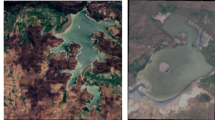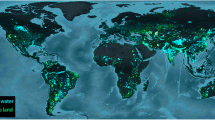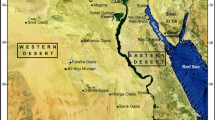Abstract
Fresh water is vital for all living creatures and maintains the hydrological cycle. Surface water bodies conserve freshwater and exhibit dynamic changes yearly due to high/low rainfall and over/underutilization. Therefore, extracting water bodies and determining their extent is imperative for effective water resource management. Water body extraction using Water Indices (WI) and Machine Learning (ML) face threshold selection and feature optimization challenges, respectively. This paper proposes a Lightweight Attention-based Multiscale Neural Network (LWAMNNet) for surface water body extraction from Linear Imaging Self Scanning‒III (LISS-III) remote sensing images. The LWAMNNet is an encoder-decoder architecture designed using a modified residual block in both the encoder and decoder to extract high-level features. Feature Extraction Module (FEM) is sandwiched between encoder and decoder to extract global contextual features. The LWAMNNet replaces convolutions with depthwise separable convolutions to reduce computation complexity. In the decoder, the attention module is incorporated to provide attention to fused features (i.e., combined deep features with spatial encoder features) at different scales. The LWAMNNet effectively extracts different-sized water bodies with non-linear boundaries. The proposed LWAMNNet qualitatively and quantitatively outperforms other DL models in performance metrics (accuracy of 99.5%) and computation complexity (in terms of trainable parameters and time). Additionally, the water extent of five major reservoirs in south India was determined annually from 2016 to 2019. Also, the reason for water dynamics is analyzed with the help of rainfall and water availability data provided by the Indian Metrological Department (IMD).


















Similar content being viewed by others
Data availability
The datasets utilized in this study can be downloaded from the National Remote Sensing Centre (NRSC), Hyderabad, Indian Space Research Organisation (ISRO), India, which is publicly accessible. Since the datasets are publicly accessible, authors are encouraged to access them via the link https:// bhuvan-app3.nrsc.gov.in/data/download/index.php. The images used for research purposes are illustrated in the manuscript.
References
Ashtekar AS, Mohammed-Aslam MA, Moosvi AR (2019) Utility of normalized difference water index and GIS for mapping surface water dynamics in sub-upper krishna basin. J Indian Soc Remote Sens 47(8):1431–1442. https://doi.org/10.1007/s12524-019-01013-6
Badrinarayanan V, Kendall A, Cipolla R (2017) SegNet: a deep convolutional encoder-decoder architecture for image segmentation. IEEE Trans Pattern Anal Mach Intell 39(12):2481–2495. https://doi.org/10.1109/tpami.2016.2644615
Bhunia GS (2021) Assessment of automatic extraction of surface water dynamism using multi-temporal satellite data. Earth Sci Inf 14(3):1433–1446. https://doi.org/10.1007/s12145-021-00612-7
Bond NR, Lake PS, Arthington AH (2008) The impacts of drought on freshwater ecosystems: an australian perspective. Hydrobiologia 600(1):3–16. https://doi.org/10.1007/s10750-008-9326-z
Cao RL, Li CJ, Liu LY, Wang JH, Yan GJ (2008) Extracting Miyun reservoir’s water area and monitoring its change based on a revised normalized different water index. Sci Surv Mapp 33:158–160
Chen L-C, Papandreou G, Kokkinos I, Murphy K, Yuille AL (2017) DeepLab: semantic image segmentation with deep convolutional nets, atrous convolution, and fully connected Crfs. IEEE Trans Pattern Anal Mach Intell 40(4):834–848. https://doi.org/10.1109/tpami.2017.2699184
Feng W, Sui H, Huang W, Chuan Xu, An K (2019) Water body extraction from very high-resolution remote sensing imagery using deep U-Net and a superpixel-based conditional random field model. IEEE Geosci Remote Sens Lett 16(4):618–622. https://doi.org/10.1109/lgrs.2018.2879492
Feyisa GL, Meilby H, Fensholt R, Proud SR (2014) Automated water extraction index: a new technique for surface water mapping using landsat imagery. Remote Sens Environ 140:23–35. https://doi.org/10.1016/j.rse.2013.08.029
Fisher A, Flood N, Danaher T (2016) Comparing landsat water index methods for automated water classification in Eastern Australia. Remote Sens Environ 175:167–182. https://doi.org/10.1016/j.rse.2015.12.055
Fu J, Wang J, Li J (2007) Study on the automatic extraction of water body from TM image using decision tree algorithm. SPIE Proceedings. https://doi.org/10.1117/12.790602
Gašparović M, Singh SK (2022) Urban surface water bodies mapping using the automatic K-Means based approach and sentinel-2 imagery. Geocarto Int. https://doi.org/10.1080/10106049.2022.2148757
Ghasemigoudarzi P, Huang W, De Silva O, Yan Q, Power D (2022) A machine learning method for inland water detection using CYGNSS Data. IEEE Geosci Remote Sens Lett 19:1–5. https://doi.org/10.1109/lgrs.2020.3020223
Guo Q, Ruiliang Pu, Li J, Cheng J (2017) A Weighted normalized difference water index for water extraction using landsat imagery. Int J Remote Sens 38(19):5430–5445. https://doi.org/10.1080/01431161.2017.1341667
Guo H, He G, Jiang W, Yin R, Yan L, Leng W (2020) A Multi-Scale Water Extraction Convolutional Neural Network (MWEN) method for Gaofen-1 remote sensing images. ISPRS Int J Geo Inf 9(4):189. https://doi.org/10.3390/ijgi9040189
Haq MA (2022) Planetscope nanosatellites image classification using machine learning. Comput Syst Sci Eng 42(3):1031–1046
Haq MA (2022b) CDLSTM: a novel model for climate change forecasting. Comput Mater Continua 71(2):2363–2381. https://doi.org/10.32604/cmc.2022.023059
Haq MA (2022c) CNN based automated weed detection system using UAV imagery. Comput Syst Sci Eng 42(2):837–849
Haq MA, Rahaman G, Baral P, Ghosh A (2021) Deep learning based supervised image classification using UAV images for forest areas classification. J Indian Soc Remote Sens 49:601–606. https://doi.org/10.1007/s12524-020-01231-3
Haq MA, Hassine SBH, Malebary SJ, Othman HA, Tag-Eldin EM (2023) 3D-cnnhr: dimensional convolutional neural network for hyperspectral super-resolution. Comput Syst Sci Eng 47:2689–2705
Haq MA, Ahsan A, Gyani J (2023) Implementation of CNN for Plant identification using UAV imagery. Inte J Adv Comput Sci Applic, 14(4). https://doi.org/10.14569/IJACSA.2023.0140441
Hosseiny B, Mahdianpari M, Hemati M, Radman A, Mohammadimanesh F, Chanussot J (2023) Beyond supervised learning in remote sensing: a systematic review of deep learning approaches. IEEE J Select Top Appl Earth Observ Remote Sens. https://doi.org/10.1109/JSTARS.2023.3316733
Huang X, Xie C, Fang X, Zhang L (2015) Combining pixel- and object-based machine learning for identification of water-body types from urban high-resolution remote-sensing imagery. IEEE J Select Top Appl Earth Observ Remote Sens 8(5):2097–2110. https://doi.org/10.1109/jstars.2015.2420713
Isikdogan F, Bovik AC, Passalacqua P (2017) Surface water mapping by deep learning. IEEE J Sel Top Appl Earth Obs Remote Sens 10(11):4909–4918. https://doi.org/10.1109/jstars.2017.2735443
Lacaux JP, Tourre YM, Vignolles C, Ndione JA, Lafaye M (2006) Classification of ponds from high-spatial resolution remote sensing: application to rift valley fever epidemics in senegal. Remote Sens Environ 106(1):66–74. https://doi.org/10.1016/j.rse.2006.07.012
Lian L, Jianfei C (2011) Spatial-temporal change analysis of water area in pearl river delta based on remote sensing technology. Procedia Environ Sci 10:2170–2175. https://doi.org/10.1016/j.proenv.2011.09.340
Liu Q, Huang C, Shi Z, Zhang S (2020) Probabilistic river water mapping from landsat-8 using the support vector machine method. Remote Sens 12(9):1374. https://doi.org/10.3390/rs12091374
Lu M, Fang L, Li M, Zhang B, Zhang Y, Ghamisi P (2022) NFANet: A novel method for weakly supervised water extraction from high-resolution remote-sensing imagery. IEEE Trans Geosci Remote Sens 60:1–14. https://doi.org/10.1109/tgrs.2022.3140323
Mangan P, Haq MA, Baral P (2019) Morphometric analysis of watershed using remote sensing and GIS—a case study of Nanganji River Basin in Tamil Nadu, India. Arab J Geosci 12:1–14. https://doi.org/10.1007/s12517-019-4382-4
Mangan P, Pandi D, Haq MA, Sinha A, Nagarajan R, Dasani T, Keshta I, Alshehri M (2022) Analytic hierarchy process based land suitability for organic farming in the arid region. Sustainability 14(8):4542. https://doi.org/10.3390/su14084542
McFEETERS SK (1996) The use of the Normalized Difference Water Index (NDWI) in the delineation of open water features. Int J Remote Sens 17(7):1425–1432. https://doi.org/10.1080/01431169608948714
Mishra K, Rama Prasad P (2015) Automatic extraction of water bodies from landsat imagery using perceptron model. J Comput Environ Sci 2015:1–9. https://doi.org/10.1155/2015/903465
Moradi M, Sahebi M, Shokri M (2017) Modified optimization water index (MOWI) for Landsat-8 OLI/TIRS. Int Arch Photogramm Remote Sens Spat Inf Sci 42:185–190
Nagaraj NR, Kumar LS (2021) Performance analysis of machine learning techniques for water body extraction. 2021 IEEE Bombay Section Signature Conference (IBSSC) Gwalior India, pp 1-6. https://doi.org/10.1109/IBSSC53889.2021.9673372
Nagaraj R, Kumar LS (2022) Multi scale feature extraction network with machine learning algorithms for water body extraction from remote sensing images. Int J Remote Sens 43(17):6349–6387. https://doi.org/10.1080/01431161.2022.2136505
NagarajKumar RLS (2021) Performance analysis of machine learning techniques for water body extraction. IEEE Bombay Section Signature Conference (IBSSC). https://doi.org/10.1109/ibssc53889.2021.9673372
Nugraha PVN, Virga P, Wibirama S, Hidayat R (2018) River body extraction and classification using enhanced models of modified normalized water difference index at Yeh Unda River Bali. 2018 International Conference on Information and Communications Technology (ICOIACT). https://doi.org/10.1109/icoiact.2018.8350789
Oki T, Kanae S (2006) Global hydrological cycles and world water resources. Science 313(5790):1068–1072. https://doi.org/10.1126/science.1128845
Oktay O, Schlemper J, Folgoc LL, Lee M, Heinrich M, Misawa K, Mori K, McDonagh S, Hammerla NY, Kainz B Glocker B (2018) Attention u-net: Learning where to look for the pancreas. arXiv preprint arXiv:1804.03999
Parveen R, Kulkarni S, Mytri VD (2017) Study of IRS 1C-LISS III image and identification of land cover features based on spectral responses. In Geospatial World Forum
Rad AM, Kreitler J, Sadegh M (2021) Augmented normalized difference water index for improved surface water monitoring. Environ Model Softw 140:105030
Raheem F (2018) Development of a new water index for landsat Operational Land Imager (OLI). Data Using Bayesian Optimization 10:05
Rajendiran N, Kumar LS (2022) Pixel level feature extraction and machine learning classification for water body extraction. Arab J Sci Eng. https://doi.org/10.1007/s13369-022-07389-x
Ronneberger O, Fischer P, Brox T (2015) U-Net: convolutional networks for biomedical image segmentation. Lect Notes Comput Sci, 234–41. https://doi.org/10.1007/978-3-319-24574-4_28
Shanmuga Priyaa S, Jeyakanthan VS, Heltin Genitha C, Sanjeevi S (2017) Estimation of water-spread area of singoor reservoir, Southern India by super resolution mapping of multispectral satellite images. J Indian Soc Remote Sens 46(1):121–130. https://doi.org/10.1007/s12524-017-0666-x
Shelhamer E, Long J, Darrell T (2017) Fully convolutional networks for semantic segmentation. IEEE Trans Pattern Anal Mach Intell 39(4):640–651. https://doi.org/10.1109/tpami.2016.2572683
Shi T, Guo Z, Li C, Lan X, Gao X, Yan X (2023) Improvement of deep learning method for water body segmentation of remote sensing images based on attention modules. Earth Sci Inform, 1–12
Sivanpillai R, Miller SN (2010) Improvements in mapping water bodies using aster data. Eco Inform 5(1):73–78. https://doi.org/10.1016/j.ecoinf.2009.09.013
Sui Y, Dongjie Fu, Wang X, Fenzhen Su (2018) Surface water dynamics in the north america arctic based on 2000–2016 landsat data. Water 10(7):824. https://doi.org/10.3390/w10070824
Wang X, Xie S, Zhang X, Chen C, Guo H, Du J, Duan Z (2018a) A robust Multi-Band Water Index (MBWI) for automated extraction of surface water from Landsat 8 OLI imagery. Int J Appl Earth Obs Geoinf 68:73–91
Wang C, Jia M, Chen N, Wang W (2018b) Long-term surface water dynamics analysis based on landsat imagery and the google earth engine platform: a case study in the middle yangtze river basin. Remote Sens 10(10):1635. https://doi.org/10.3390/rs10101635
Wang Y, Li Z, Zeng C, Xia G, Shen H (2020a) An urban water extraction method combining deep learning and google earth engine. IEEE J Select Top Appl Earth Observ Remote Sens 13:769–782. https://doi.org/10.1109/jstars.2020.2971783
Wang Z, Gao X, Zhang Y, Zhao G (2020b) MSLWENet: a novel deep learning network for lake water body extraction of google remote sensing images. Remote Sensing 12(24):4140. https://doi.org/10.3390/rs12244140
Wangchuk S, Bolch T (2020) Mapping of glacial lakes using sentinel-1 and sentinel-2 data and a random forest classifier: Strengths and Challenges. Sci Remote Sens 2:100008. https://doi.org/10.1016/j.srs.2020.100008
Weng L, Yiming Xu, Xia M, Zhang Y, Liu J, Yiqing Xu (2020) Water areas segmentation from remote sensing images using a separable Residual SegNet network. ISPRS Int J Geo Inf 9(4):256. https://doi.org/10.3390/ijgi9040256
Xu H (2006) Modification of Normalised Difference Water Index (NDWI) to enhance open water features in remotely sensed imagery. Int J Remote Sens 27(14):3025–3033. https://doi.org/10.1080/01431160600589179
Yang J, Xianrong Du (2017) An enhanced water index in extracting water bodies from landsat TM imagery. Ann GIS 23(3):141–148. https://doi.org/10.1080/19475683.2017.1340339
Yin Y, Guo Y, Deng L, Chai B (2022) Improved pspnet-based water shoreline detection in complex inland river scenarios. Complex IntellSyst. https://doi.org/10.1007/s40747-022-00793-8
Yu L, Wang Z, Tian S, Ye F, Ding J, Kong J (2017) Convolutional neural networks for water body extraction from landsat imagery. Int J Comput Intell Appl 16(01):1750001. https://doi.org/10.1142/s1469026817500018
Zhao H, Shi J, Qi X, Wang X, Jia J (2017) Pyramid scene parsing network. 2017 IEEE Conference on Computer Vision and Pattern Recognition (CVPR). https://doi.org/10.1109/cvpr.2017.660
Acknowledgements
We gratefully acknowledge the National Remote Sensing Centre (NRSC), Hyderabad, Indian Space Research Organisation (ISRO), India, for supplying the Resourcesat-2: LISS-III image data for educational purposes. We also thank the National Institute of Technology Puducherry in Karaikal, India, for providing research facilities.
Funding
The authors declare that they did not receive any financial support or grants for this study.
Author information
Authors and Affiliations
Contributions
Every author has contributed to the successful compilation of this study. Nagaraj. R: Data collection, validation, Methodology, Software, Formal Analysis, and Writing - original draft. original draft. Lakshmi Sutha Kumar: Conceptualization, and Supervision. All authors read and approved the final manuscript.
Corresponding author
Ethics declarations
Competing interests
The authors declare no competing interests.
Additional information
Communicated by: H. Babaie
Publisher's Note
Springer Nature remains neutral with regard to jurisdictional claims in published maps and institutional affiliations.
Rights and permissions
Springer Nature or its licensor (e.g. a society or other partner) holds exclusive rights to this article under a publishing agreement with the author(s) or other rightsholder(s); author self-archiving of the accepted manuscript version of this article is solely governed by the terms of such publishing agreement and applicable law.
About this article
Cite this article
Nagaraj, R., Kumar, L.S. LWAMNNet: A novel deep learning framework for surface water body extraction from LISS-III satellite images. Earth Sci Inform 17, 561–592 (2024). https://doi.org/10.1007/s12145-023-01187-1
Received:
Accepted:
Published:
Issue Date:
DOI: https://doi.org/10.1007/s12145-023-01187-1




